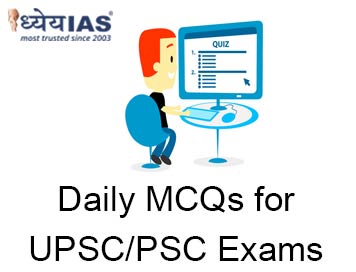Home > Daily-mcqs
Daily-mcqs 10 May 2025

Q1:
With reference to modern air defence systems, consider the following statements: How many of the above statements are correct?
A: Only one
B: Only two
C: All three
D: None
Answer: B
Explanation:
Among the given statements, only two are correct. The S-400 Triumf is indeed a long-range air defence system capable of intercepting high-altitude threats, including ballistic missiles—so statement 2 is correct. Electronic warfare (EW) systems can neutralise threats non-kinetically by jamming, spoofing, or interfering with enemy radar and communication, making statement 3 also correct. However, Akash and Barak are not man-portable systems. They are medium-range surface-to-air missile systems, typically deployed on mobile platforms. MANPADS like Igla or QW-18, used by soldiers on the ground, fall into the short-range man-portable category. Therefore, statement 1 is incorrect.
Q2:
Consider the following statements and choose from the options below: Statement–1: Predatory pricing becomes a regulatory challenge due to ambiguity in defining "cost."
Statement–2: The Competition Act, 2002 clearly defines Average Total Cost as the legal standard for cost assessment.
A: Both statements are correct, and Statement 2 explains Statement 1
B: Both statements are correct, but Statement 2 does not explain Statement 1
C: Statement 1 is correct, but Statement 2 is incorrect
D: Statement 1 is incorrect, but Statement 2 is correct
Answer: C
Explanation:
Statement 1 is correct—predatory pricing has historically been difficult to regulate because there was no agreed-upon legal interpretation of "cost." This vagueness made enforcement inconsistent. Statement 2 is incorrect because the Competition Act, 2002 did not define Average Total Cost as a standard. In fact, the recent CCI framework introduces Average Variable Cost (AVC) as the benchmark. This correction was necessary to provide both clarity and enforceability under Section 4 of the Act, which prohibits abuse of market dominance, including selling below cost to eliminate competitors.
Q3:
With reference to India’s automobile sector, consider the following statements: How many of the above statements are correct?
A: Only one
B: Only two
C: All three
D: None
Answer: A
Explanation:
Statement 1 is incorrect — the automobile sector contributes 7.1%, not over 10%, to India’s GDP.
Statement 2 is correct — India is the world’s largest manufacturer of buses.
Statement 3 is incorrect — India’s EV market is projected to reach ₹50,000 crore (~$7.09 billion) by 2025.
Thus, one statement is correct.
Q4:
With reference to the High Courts in India, consider the following statements: How many of the above statements are correct?
A: Only one
B: Only two
C: All three
D: None
Answer: A
Explanation:
· Statement 1 is incorrect: Article 215 makes High Courts courts of record, meaning their proceedings have evidentiary value and are preserved permanently.
· Statement 2 is incorrect: writ powers are provided under Article 226, not Article 227. Article 227 gives the High Courts supervisory jurisdiction, not writ power.
· Statement 3 is correct: Article 217 governs the appointment of High Court judges by the President in consultation with the Chief Justice of India and the Governor of the concerned state.
Q5:
Match the following institutional bodies with their primary functions: List I (Institution) List II (Function) A. CERT-In 1. Cyber emergency response B. NTRO 2. Technical intelligence C. NIA 3. Diplomatic engagement on counter-terrorism D. MEA Counter-Terrorism Cell 4. Investigating terrorism cases How many pairs are correctly matched?
A: Only one
B: Only Two
C: Only Three
D: All four
Answer: C
Explanation:
CERT-In (Indian Computer Emergency Response Team) is responsible for cyber emergency response (A-1). NTRO (National Technical Research Organisation) specializes in technical intelligence (B-2), while the NIA (National Investigation Agency) handles the investigation of terrorism cases (C-4). However, the MEA’s Counter-Terrorism Cell mainly facilitates diplomatic coordination and international cooperation against terrorism, not direct operational or investigative functions like the NIA. Therefore, only three pairs—A-1, B-2, and C-4—are correctly matched. The mismatch in D-3 excludes it from the count, making the correct answer option (c) Three.